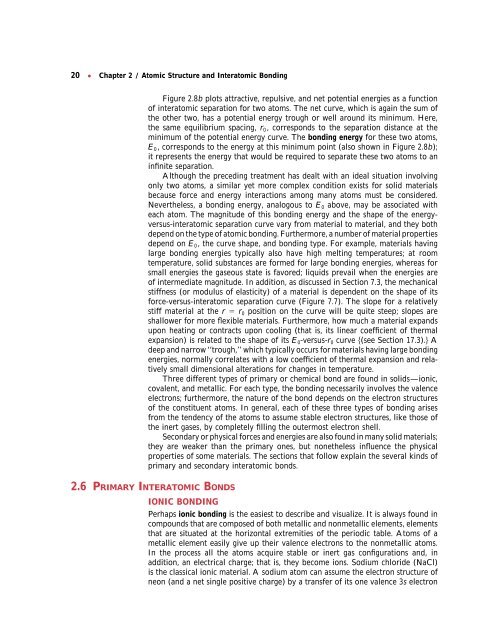Chapter 2 / Atomic Structure and Interatomic Bonding
Chapter 2 / Atomic Structure and Interatomic Bonding
Chapter 2 / Atomic Structure and Interatomic Bonding
You also want an ePaper? Increase the reach of your titles
YUMPU automatically turns print PDFs into web optimized ePapers that Google loves.
20 ● <strong>Chapter</strong> 2 / <strong>Atomic</strong> <strong>Structure</strong> <strong>and</strong> <strong>Interatomic</strong> <strong>Bonding</strong><br />
Figure 2.8b plots attractive, repulsive, <strong>and</strong> net potential energies as a function<br />
of interatomic separation for two atoms. The net curve, which is again the sum of<br />
the other two, has a potential energy trough or well around its minimum. Here,<br />
the same equilibrium spacing, r 0, corresponds to the separation distance at the<br />
minimum of the potential energy curve. The bonding energy for these two atoms,<br />
E 0, corresponds to the energy at this minimum point (also shown in Figure 2.8b);<br />
it represents the energy that would be required to separate these two atoms to an<br />
infinite separation.<br />
Although the preceding treatment has dealt with an ideal situation involving<br />
only two atoms, a similar yet more complex condition exists for solid materials<br />
because force <strong>and</strong> energy interactions among many atoms must be considered.<br />
Nevertheless, a bonding energy, analogous to E 0 above, may be associated with<br />
each atom. The magnitude of this bonding energy <strong>and</strong> the shape of the energyversus-interatomic<br />
separation curve vary from material to material, <strong>and</strong> they both<br />
depend on the type of atomic bonding. Furthermore, a number of material properties<br />
depend on E 0, the curve shape, <strong>and</strong> bonding type. For example, materials having<br />
large bonding energies typically also have high melting temperatures; at room<br />
temperature, solid substances are formed for large bonding energies, whereas for<br />
small energies the gaseous state is favored; liquids prevail when the energies are<br />
of intermediate magnitude. In addition, as discussed in Section 7.3, the mechanical<br />
stiffness (or modulus of elasticity) of a material is dependent on the shape of its<br />
force-versus-interatomic separation curve (Figure 7.7). The slope for a relatively<br />
stiff material at the r r 0 position on the curve will be quite steep; slopes are<br />
shallower for more flexible materials. Furthermore, how much a material exp<strong>and</strong>s<br />
upon heating or contracts upon cooling (that is, its linear coefficient of thermal<br />
expansion) is related to the shape of its E 0-versus-r 0 curve (see Section 17.3). A<br />
deep <strong>and</strong> narrow ‘‘trough,’’ which typically occurs for materials having large bonding<br />
energies, normally correlates with a low coefficient of thermal expansion <strong>and</strong> relatively<br />
small dimensional alterations for changes in temperature.<br />
Three different types of primary or chemical bond are found in solids—ionic,<br />
covalent, <strong>and</strong> metallic. For each type, the bonding necessarily involves the valence<br />
electrons; furthermore, the nature of the bond depends on the electron structures<br />
of the constituent atoms. In general, each of these three types of bonding arises<br />
from the tendency of the atoms to assume stable electron structures, like those of<br />
the inert gases, by completely filling the outermost electron shell.<br />
Secondary or physical forces <strong>and</strong> energies are also found in many solid materials;<br />
they are weaker than the primary ones, but nonetheless influence the physical<br />
properties of some materials. The sections that follow explain the several kinds of<br />
primary <strong>and</strong> secondary interatomic bonds.<br />
2.6 PRIMARY INTERATOMIC BONDS<br />
IONIC BONDING<br />
Perhaps ionic bonding is the easiest to describe <strong>and</strong> visualize. It is always found in<br />
compounds that are composed of both metallic <strong>and</strong> nonmetallic elements, elements<br />
that are situated at the horizontal extremities of the periodic table. Atoms of a<br />
metallic element easily give up their valence electrons to the nonmetallic atoms.<br />
In the process all the atoms acquire stable or inert gas configurations <strong>and</strong>, in<br />
addition, an electrical charge; that is, they become ions. Sodium chloride (NaCl)<br />
is the classical ionic material. A sodium atom can assume the electron structure of<br />
neon (<strong>and</strong> a net single positive charge) by a transfer of its one valence 3s electron



